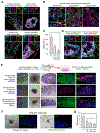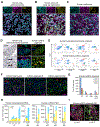Organoid Modeling of the Tumor Immune Microenvironment
- PMID: 30550791
- PMCID: PMC6656687
- DOI: 10.1016/j.cell.2018.11.021
Organoid Modeling of the Tumor Immune Microenvironment
Abstract
In vitro cancer cultures, including three-dimensional organoids, typically contain exclusively neoplastic epithelium but require artificial reconstitution to recapitulate the tumor microenvironment (TME). The co-culture of primary tumor epithelia with endogenous, syngeneic tumor-infiltrating lymphocytes (TILs) as a cohesive unit has been particularly elusive. Here, an air-liquid interface (ALI) method propagated patient-derived organoids (PDOs) from >100 human biopsies or mouse tumors in syngeneic immunocompetent hosts as tumor epithelia with native embedded immune cells (T, B, NK, macrophages). Robust droplet-based, single-cell simultaneous determination of gene expression and immune repertoire indicated that PDO TILs accurately preserved the original tumor T cell receptor (TCR) spectrum. Crucially, human and murine PDOs successfully modeled immune checkpoint blockade (ICB) with anti-PD-1- and/or anti-PD-L1 expanding and activating tumor antigen-specific TILs and eliciting tumor cytotoxicity. Organoid-based propagation of primary tumor epithelium en bloc with endogenous immune stroma should enable immuno-oncology investigations within the TME and facilitate personalized immunotherapy testing.
Keywords: PD-1; PDO; T cell receptor; TCR; cancer; checkpoint inhibitor; immunotherapy; organoid; single-cell RNA-seq; tumor-infiltrating lymphocyte.
Copyright © 2018 Elsevier Inc. All rights reserved.
Conflict of interest statement
DECLARATION OF INTERESTS
C.J.K. and J.T.N. are inventors on a patent describing the ALI PDO method. G.X.Y.Z and V.G. are employees and shareholders of 10X Genomics. C.J.K. is a founder, scientific advisory board member and shareholder of both TOMA Biosciences and Surrozen, Inc. C.J.K. is a consultant for BioTechne. D.M-V., F.M.DLV are employees and shareholders in TOMA Biosciences. WCH is a consultant for Thermo Fisher, AjuIB, MPM Capital, and Paraxel and receives research support from Deerfield. WCH is a founder, has equity and consults for KSQ Therapeutics.
Figures







Comment in
-
Organoid 2.0.Nat Rev Cancer. 2019 Mar;19(3):126-127. doi: 10.1038/s41568-019-0108-x. Nat Rev Cancer. 2019. PMID: 30670821 No abstract available.
-
Novel Three-Dimensional Cultures of Patient-Derived Cancer and Tumor Immune Cells.Gastroenterology. 2019 Jul;157(1):260-261. doi: 10.1053/j.gastro.2019.05.036. Epub 2019 May 25. Gastroenterology. 2019. PMID: 31136743 No abstract available.
References
-
- Bailey P, Chang DK, Nones K, Johns AL, Patch AM, Gingras MC, Miller DK, Christ AN, Bruxner TJ, Quinn MC, et al. (2016). Genomic analyses identify molecular subtypes of pancreatic cancer. Nature 531, 47–52. - PubMed
Publication types
MeSH terms
Substances
Grants and funding
- U01 CA176299/CA/NCI NIH HHS/United States
- U24 DK085532/DK/NIDDK NIH HHS/United States
- U01 DK085527/DK/NIDDK NIH HHS/United States
- T32 HL098049/HL/NHLBI NIH HHS/United States
- U01 DE025188/DE/NIDCR NIH HHS/United States
- U01 CA176058/CA/NCI NIH HHS/United States
- U01 DK085532/DK/NIDDK NIH HHS/United States
- T32 HL120824/HL/NHLBI NIH HHS/United States
- R01 CA251514/CA/NCI NIH HHS/United States
- U54 CA224081/CA/NCI NIH HHS/United States
- HHMI/Howard Hughes Medical Institute/United States
- U19 AI057229/AI/NIAID NIH HHS/United States
- U01 CA199241/CA/NCI NIH HHS/United States
- U01 CA217851/CA/NCI NIH HHS/United States
- U19 AI116484/AI/NIAID NIH HHS/United States
LinkOut - more resources
Full Text Sources
Other Literature Sources
Molecular Biology Databases
Research Materials

